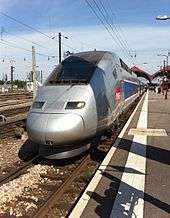SNCF TGV POS
| TGV POS | |
|---|---|
 | |
| In service | 2006 |
| Manufacturer | Alstom |
| Number built | 19 |
| Formation | 2 motor cars + 8 trailers |
| Operator(s) | SNCF, SBB |
| Line(s) served |
LGV Est LGV Rhin-Rhône |
| Specifications | |
| Train length | 200.19 m (657 ft) |
| Car length | (?) |
| Width |
Motor car 2.81 m (9 ft 3 in) Trailer 2.904 m (9 ft 6.3 in) |
| Height |
4.1 m (13 ft 5 in) (power car), 3.42 m (11 ft 3 in) (trailer) |
| Maximum speed | 320 km/h (199 mph) |
| Weight | 383 t (377 long tons; 422 short tons) (empty) |
| Acceleration |
≥1.7 km/h/s(0-100km/h), |
| Electric system(s) |
25kV 50Hz / 15kV 16.7Hz Overhead catenary |
| Current collection method | CX Pantograph |
| Track gauge | 1,435 mm (4 ft 8 1⁄2 in) standard gauge |

The TGV POS is a TGV train built by French manufacturer Alstom which is operated by the French national rail company, the SNCF, in France's high-speed rail lines. It was originally ordered by the SNCF for use on the new LGV Est, which was put into service in 2007. "POS" stands for Paris-Ostfrankreich-Süddeutschland (German for Paris, Eastern France, Southern Germany).
Each train is formed of eight existing TGV Réseau single-deck carriages paired with new power cars, with a total power output of 9.6 MW (12,900 hp) and a top speed of 320 kilometres per hour (199 mph) under 25 kV. The TGV Réseau power cars thus freed have been matched to new TGV Duplex carriages to create TGV Duplex - TGV Réseau hybrid sets. This is because traffic on the LGV Est is expected to be less than on the heavily congested LGV Sud-Est.
Like the TGV TMST, the TGV POS power cars have asynchronous motors and, in case of failure, isolation of an individual motor in a powered bogie is possible. By using IGBT power packs, the new power cars are capable of developing 75% of their full rated power under 15 kV German and Swiss electrifications, compared to 45% for existing TGV power cars. This allows POS trains to operate at the same speed as Intercity-Express trains in Germany.
The TGV POS links France with Germany and Switzerland. In Switzerland, it travels from Basel to Zurich and on the line from Vallorbe to Lausanne coming from Paris.
Each TGV POS trainset weighs 383 t (377 long tons; 422 short tons) and is numbered in the 4400 series. The livery is the same as that of TGV Réseau sets (silver and blue). Pre-production set No 4401 had a prototype livery similar as the one used on the TGV Duplex sets but, in March 2007, the blue areas were stickered over with silver and was now in appearance the same as the other sets.
Since 2013, all of the TGV POS trainsets operate under the TGV Lyria brand and livery (a joint-venture by SNCF and the Swiss Federal Railways) with services between France and Switzerland, replacing the nine SNCF TGV Sud-Est trainsets that were taken out of service.
World rail speed record
On 3 April 2007 a train using both power cars of the TGV POS trainset number 4402 set a new world speed record for travel on conventional rails. The train reached 574.8 km/h (357.2 mph).[1] As part of a series of increasingly faster runs that culminated in the official record attempt, it set an unofficial speed record of 554.3 km/h (344.4 mph) on 13 February 2007.[2]
The trainset comprised three specially modified Duplex cars, fitted with two powered bogies similar to the AGV prototype, marshalled between the TGV POS power cars. The record trainset, configured as Bo'Bo'+2'Bo'Bo'2'+Bo'Bo', had four more powered axles than trainset 325 during the 1990 speed record, and had a theoretical maximum power output of 19.6 MW (26,300 hp) instead of the 9.3 MW (12,500 hp) on a standard TGV. Over 600 sensors were fitted on various parts of both the engines and the cars.
The train set ran with larger wheels, and the catenary voltage was increased to 31 kV from the standard 25 kV.[3] The maximum speed was achieved near kilometer post 193 on the LGV Est between Meuse and Champagne-Ardenne TGV stations.
See also
| Wikimedia Commons has media related to TGV POS. |
References
- ↑ "French train sets new world record", NDTV.com, retrieved 3 April 2007
- ↑ "French high-speed TGV breaks world conventional rail-speed record". Deutsche Presse-Agentur (reprinted by Monsters and Critics). 2007-02-14. Retrieved 2007-02-14.
- ↑ "2007 record attempt". BBC News Online. 2007-04-03. Retrieved 2010-01-04.